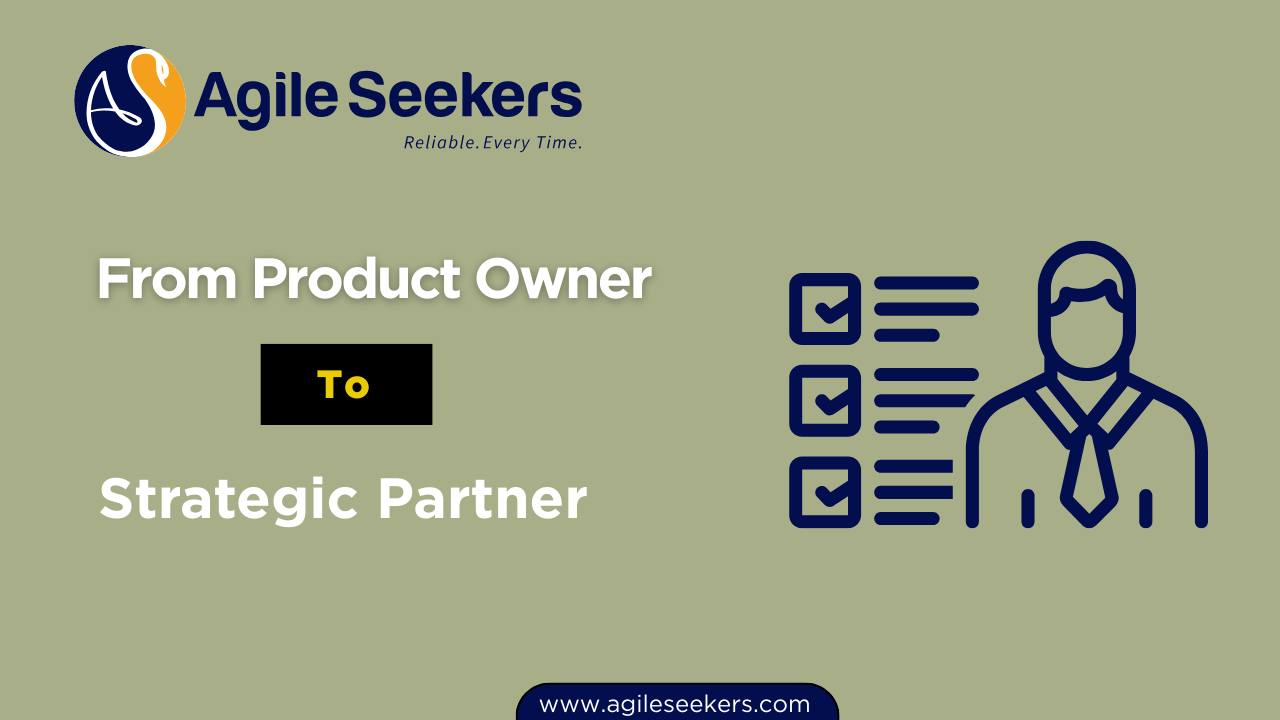From Product Owner to Strategic Partner: Evolving the POPM Role

The Product Owner/Product Manager (POPM) role has changed. What used to be a job focused on writing stories and prioritizing backlogs is now about driving strategy, influencing outcomes, and working directly with business leaders. This shift from Product Owner to Strategic Partner is not a buzzword—it’s a reflection of how organizations operate in the real world.
As companies scale Agile using the SAFe® framework, they need people who don’t just manage features but guide teams and stakeholders toward real business value.
The Old Role: Tactical, Team-Focused
In traditional Agile teams, Product Owners worked closely with developers. They created user stories, prioritized the backlog, and accepted completed work. The focus was mostly inside the team. Business decisions and customer strategy stayed with senior leaders.
That worked when product complexity was low. But enterprise environments are different. Now, decisions happen faster, competition is stronger, and product teams must stay aligned with business goals.
The New Role: Strategic, Business-Facing
The shift from Product Owner to Strategic Partner means stepping beyond team-level execution. Today’s POPMs work across teams, business units, and customer touchpoints. They connect product decisions to business priorities and use data to guide every move.
The SAFe POPM Certification focuses on this evolution. It teaches POPMs to align features with strategy, make customer-driven decisions, and lead across the organization.
What Strategic POPMs Actually Do
1. Focus on Outcomes, Not Just Outputs
Strategic POPMs don’t stop at delivering features. They ask: Did this feature solve the problem? Did it improve customer satisfaction or revenue? They measure what matters and adjust based on results.
2. Tie Work to Business Goals
POPMs now work with senior leaders to understand strategy. They translate that strategy into features and initiatives. During PI Planning, they make sure team priorities support business outcomes—not just technical goals.
This is a core part of SAFe Product Owner Certification training. The course pushes product professionals to lead, not just follow directions.
3. Lead with Facts, Not Opinions
Gut feeling isn’t enough. Strategic POPMs rely on real data: customer feedback, product usage, lead times, and flow metrics. They use that data to prioritize work and explain their choices to stakeholders.
4. Work Across the Value Stream
Today’s product managers think beyond team boundaries. They work with other teams, system architects, and product leaders to deliver end-to-end value. It’s not just about the next feature—it’s about how that feature fits into the bigger picture.
That’s why the SAFe Product Owner/Manager Certification teaches value stream thinking and systems-level collaboration.
5. Earn a Seat at the Table
Strategic POPMs attend leadership meetings, contribute to investment discussions, and help set product direction. They bring in ground-level insights that help shape high-level decisions.
This shift is not accidental—it happens because these professionals build trust by speaking the language of both business and technology.
Why This Change Matters
This evolution isn’t just good for POPMs—it’s good for organizations. When Product Owners act as strategic partners, companies move faster, make better decisions, and deliver what customers actually need.
Let’s break it down:
-
Faster Decisions: When POPMs understand both the business strategy and the tech constraints, they make smart calls without delays.
-
Better Products: Customer feedback is built into the process, so teams stop guessing and start solving real problems.
-
Stronger Teams: Teams work better when the “why” behind their work is clear. A strong POPM gives them that clarity.
-
Real Alignment: Instead of having business and tech pull in different directions, the POPM keeps them on the same path.
What You Need to Make the Shift
Making the move from Product Owner to Strategic Partner takes time. But with the right focus, it’s doable.
Here’s what helps:
1. Learn the Business
You can’t influence business goals if you don’t understand them. Spend time with finance, marketing, sales, and customers. Ask questions. Learn what drives revenue and retention.
2. Get the Right Training
The SAFe POPM training teaches how to work at the strategic level. It covers lean thinking, portfolio flow, economic prioritization, and customer-focused delivery.
3. Use Metrics That Matter
Start using data in every conversation—cycle time, customer feedback, feature adoption, NPS. Use these numbers to back up your roadmap and influence others.
4. Speak in Business Language
Drop the technical jargon when talking to leaders. Focus on impact: What problem are we solving? How will this help the business grow? What’s the return?
5. Collaborate Outside Your Team
Make connections with other product managers, architects, and stakeholders. Build coalitions. Drive shared goals. Don’t wait to be invited—take the lead.
The Bottom Line
The role of the POPM has changed, and that’s a good thing. Organizations don’t need task managers—they need strategic leaders. Product professionals who can balance business goals, technical realities, and customer needs.
If you’re in the POPM role today, it’s time to level up. Move beyond the backlog. Think long-term. Ask the bigger questions. Make decisions that shape not just the next sprint, but the future of your product.
Start with the right mindset. Build the right skills. And if you want structured support, the SAFe POPM Certification is a strong next step. It’s more than a credential—it’s a signal that you’re ready to lead, not just follow.




















